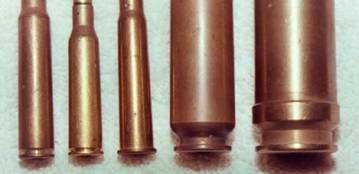Cartridge
Identification
By Cliff Carlisle
With the multitude
of caliber’s that have existed for over 150 years, there has been a problem
of identifying which round is which. A system was developed years
ago that uses the metric system to identify each round.
In the system, the
first number listed is the diameter of the bullet. Then an X (by)
is used before the case length is listed. An example is 7.92X57 (the
German WW1 & 2 rifle & MG round commonly called the 8mm Mauser
in the US). The 7.92 is the diameter of the bullet in millimeters.
The 57 is the length of the cartridge case in millimeters. It’s normally
referred to as the 7.92 by 57. The US didn’t start using the metric
designation until the adoption of the M14 rifle in 7.62X51 NATO in 1957.
The US WW1 & 2 rifle & MG cartridge was the .30 Caliber Model 1906.
This was commonly called the 30-06. .30 caliber adopted in 1906.
The metric designation is 7.62X63. As can be seen, 7.62X63 is easier
to use to physically ID the round than 30-06 is.
The above designations
are for rimless rounds. If the round has a rim an R is added to the
designation. An example is the 7.7X56R for the WW2 Japanese Navy
MG round.
If the round has a
semi rim (which means it has a rim about half the size of a rimmed round
& has an extractor groove like a rimless round) a Sr is added.
An example is the 6.5X51Sr used in the Japanese Type 38 rifle.
If the round has a
rim smaller than the head of the cartridge it is called a rebated rim.
A Rb was added in this instance. An example is the 20X80Rb WW2 German
rounds used in the MGFF aircraft cannon.
If the round has a
belt added to the head just above the extractor groove to strengthen it
a B is added to the designation. An example it the 20X138B WW2 German
rounds used in their light anti aircraft guns.

Rimless,
semi-rimmed, rimmed, rebated rim & belted examples.